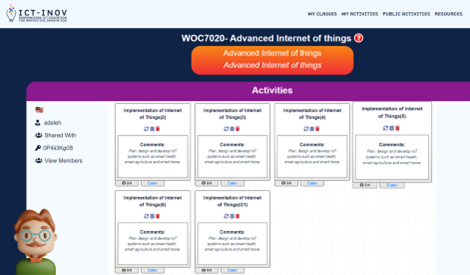
Description of the course
The course provides students with an in-depth understanding of the cutting-edge technologies, applications, and challenges in the rapidly evolving field of IoT. Building upon foundational IoT concepts, the course delves into advanced topics that enable students to develop innovative and scalable IoT solutions.
Description of the participants
This is graduate level course. Participants are enrolled in the Master’s of Computer Science or Master’s of Software Engineering programs. A total of 24 students attended the courses in semester 1 of academic year 2022 – 2023. The course was conducted using a blended approach, consisting of 70% on-line sessions and 30% in-person interactions.
Description of gamified design thinking activities
Design Thinking methodologies and tools were applied to foster creativity and innovation. The objective was to improve problem-solving skills and enable students to develop innovative IoT solutions that addressed real-world challenges effectively. The course integrated a series of key design thinking steps and corresponding tools, empowering students to think from a user-centric perspective and approach IoT development iteratively. Students worked in groups of 4 individuals.
The following activities were performed by the students.
Step 1. Team building and project setup.
Students identified clear roles and responsibilities for each team member to ensure high performance.
Step 2. Selecting an IoT project.
Each group selected one specific field for IoT implementation, such as smart home, smart agriculture, or smart health.
Step 3. Literature review.
Teams conducted systematic literature review of scholarly articles related to IoT challenges in the chosen field, delivered in the period 2018 – 2023. They further developed a systematic literature review paper to analyze and summarize findings.
Step 4. Empathy.
Students engaged in empathy-building activities by conducting interviews, observations, and surveys with end-users and stakeholders. Through the use of tools such as empathy mapping, user persona creation, and journey mapping, they gained valuable insights into user needs and pain points.
Step 5. Define.
Based on the gathered insights, students formulated well-defined problem statements and design challenges. Brainstorming sessions and affinity diagramming helped them refine the problem scope and identify specific areas where IoT technology could have a significant impact.
Step 6. Ideation.
Students used various ideation techniques, including brainstorming, mind mapping, and SCAMPER, to generate a wide range of creative ideas and potential solutions for IoT challenges.
Step 7. Prototyping.
Students assembled the hardware required for implementing their IoT solution, such as LoraWAN®, Arduino®, or Rasberry Pi®. They further used sensors and actuators compatible with microcontrollers. They creatively used a 3D pen and laser cutter to design and prototype components for the IoT solution. They established wireless connectivity through LoraWAN® for seamless communication.
Step 8. Testing.
Students conducted usability tests and gathered feedback from potential users to evaluate the effectiveness of their prototypes. Observing user interactions enabled them to identify areas for improvement and refine their IoT designs accordingly.
Step 9. Development of final report.
Students wrote a comprehensive research paper on the IoT adoption journey and challenges in the specific field. They incorporated the findings from the systematic literature review to support the research.
Step 10. Oral presentation.
Students presented the completed IoT solution and project experiences in a 30-minute oral presentation. They highlighted teamwork, challenges faced, decision-making processes, and innovative aspects of the designs and implementations. They effectively communicated the comprehensive IoT adoption journey and showcased the application of design thinking methodologies in solving real-world IoT challenges in the chosen field.
Other design thinking principles used in project implementation include:
- Iteration. Based on user feedback and testing results, students iterated and refined their prototypes, continually improving their IoT solutions. This iterative approach allowed them to respond to evolving user needs and optimize their designs.
- Collaboration and co-creation. Throughout the course, students engaged in collaborative team projects, fostering co- creation and group problem-solving. This collaboration encouraged diverse perspectives and enhanced students’ ability to work effectively in interdisciplinary IoT teams.
By incorporating design thinking methodologies and tools in the Advanced IoT Course, students were empowered to approach IoT challenges with a human-centric mindset, create user-focused solutions, and develop the ability to tackle complex problems creatively. This multidimensional approach not only enhanced their technical skills but also prepared them to become versatile and empathetic IoT innovators in the professional world.






